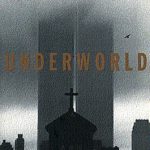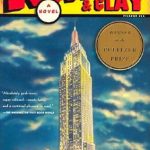
The term “Great American Novel” ™ (or GAN) was coined in 1868 by the novelist John William DeForest. In Paperback Riders we‘ve covered novels from ‘Uncle Tom’s Cabin’ published in 1852 to 2010’s ‘Lean On Pete’ by Willy Vlautin, and several books that feature on lists of Great American Novels. As many of these are fifty, a hundred or even a hundred and fifty years old they don’t describe today’s America. So, what does the GAN look like at the end of the first quarter of the 21st Century?
When PBS ran a poll in 2018 to find America’s best-loved novel ‘To Kill a Mockingbird’ came out on top, by a wide margin. Harper Lee’s gripping, heart-wrenching, coming-of-age tale set in a South poisoned by virulent prejudice. It views a world of great beauty and savage inequities through the eyes of a young girl, as her father—a crusading local lawyer—risks everything to defend a black man unjustly accused of a terrible crime. Lee’s book often appears on lists of GAN’s. The rest of the top picks in The Great American Read suggest that America’s reading habits tend towards popular fiction and British writers. Number two was the ‘Outlander’ series. Written by Arizona author Diana J. Gabaldon, this is a set of 5 novels (so far) and other works, including a TV series. ‘Outlander’ focuses on 20th-century British nurse Claire Randall, who time travels to 18th-century Scotland and finds adventure and romance in the Highlands. It bobs back and forth in time and ends up with the protagonists fighting in the War of Independence. The rest of the top ten in the Great American Read included ‘Harry Potter’, Jane Austen, ‘Lord of the Rings’, and ‘Narnia’. The next GAN contenders to appear in the list were ‘Grapes of Wrath’ at 12 and ‘The Great Gatsby’ at 15.
Literary fiction, which is what the Great American Novel is after all, has always been a minority sport. When The Times asked a similar question in the UK ‘To Kill a Mockingbird’ came out close to the top again, with Stieg Larsson’s ‘The Girl Who Kicked the Hornet’s Nest’, Danielle Steel, and Tom Clancy in the top five. Little classic English Literature was on the list. Indeed, it looks like Americans read it more than we do.
If our quest here is to understand modern America through its literature, then where should we look? There are three books that appear on nearly every list.
 Don DeLillo, ‘Underworld’: This 1997 novel is centered on the efforts of Nick Shay, a waste management executive from the Bronx to trace the history of the baseball that won the New York Giants the pennant in 1951, the legendary “Shot Heard ‘Round the World”. It covers a range of subplots drawn from American history in the second half of the twentieth century. Described as both postmodernist and a reaction to postmodernism. It examines themes of nuclear proliferation, waste, and the contribution of individual lives to the course of history. Many of the characters spend their time taking rubbish and discarded items, everything from military planes to coke bottles, and creating artworks from them. DeLillo presents this as a metaphor for personal and political life in the USA. It’s a stunning book, a dense read but one worth persevering with.
Don DeLillo, ‘Underworld’: This 1997 novel is centered on the efforts of Nick Shay, a waste management executive from the Bronx to trace the history of the baseball that won the New York Giants the pennant in 1951, the legendary “Shot Heard ‘Round the World”. It covers a range of subplots drawn from American history in the second half of the twentieth century. Described as both postmodernist and a reaction to postmodernism. It examines themes of nuclear proliferation, waste, and the contribution of individual lives to the course of history. Many of the characters spend their time taking rubbish and discarded items, everything from military planes to coke bottles, and creating artworks from them. DeLillo presents this as a metaphor for personal and political life in the USA. It’s a stunning book, a dense read but one worth persevering with.
 David Foster Wallace, ‘Infinite Jest’: From 1996 another novel with an interest in waste. The multiple subplots are set in an addicts’ halfway house and a tennis academy, and featuring the Incandenza family, a sort of literary Simpsons meets the Addams Family. Themes include many of the problems besetting the USA on either side of the new century. Mental health, suicide, sadness, addiction, and the entertainment industry, through the film called ‘Infinite Jest’, that draws the threads of the book together. I found this almost unreadable thanks to an unusual structure with masses of end notes, but you may like it better than I did.
David Foster Wallace, ‘Infinite Jest’: From 1996 another novel with an interest in waste. The multiple subplots are set in an addicts’ halfway house and a tennis academy, and featuring the Incandenza family, a sort of literary Simpsons meets the Addams Family. Themes include many of the problems besetting the USA on either side of the new century. Mental health, suicide, sadness, addiction, and the entertainment industry, through the film called ‘Infinite Jest’, that draws the threads of the book together. I found this almost unreadable thanks to an unusual structure with masses of end notes, but you may like it better than I did.
 Michael Chabon, ‘The Amazing Adventures of Kavalier and Clay’: This follows the lives of two Jewish cousins, Czech artist Joe Kavalier and Brooklyn-born writer Sammy Clay, before, during, and after World War II. They become major figures in the golden age of the comics industry, and many of the events are drawn from lives of real-life comic book figures. I found this quite readable, taking escapism of all sorts as its theme, something that many other GAN contenders share.
Michael Chabon, ‘The Amazing Adventures of Kavalier and Clay’: This follows the lives of two Jewish cousins, Czech artist Joe Kavalier and Brooklyn-born writer Sammy Clay, before, during, and after World War II. They become major figures in the golden age of the comics industry, and many of the events are drawn from lives of real-life comic book figures. I found this quite readable, taking escapism of all sorts as its theme, something that many other GAN contenders share.
In reviewing John Dos Passos, ‘U.S.A’ trilogy from the 1930s, Norman Mailer said “The Great American Novel is no longer writable. We can’t do what John Dos Passos did. You can’t cover all of America now. It’s too detailed. You couldn’t just stick someone in Tampa without knowing about Tampa. You couldn’t get away with it. People didn’t get upset if you were a little scanty on the details in the past.” And looking at the books we’ve covered in the last year or two they do often turn the magnifying glass on small areas or aspects of American life. In reality many Great American Novels from ‘The Great Gatsby‘ to ‘Grapes of Wrath’ are snapshots of small aspects of American life, so Mailer is probably wrong. The Great American Novel is still being written, and we will go on reading them and reporting on them.


